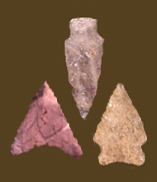
|
MADISON
Chronology For information about similar Archaic Period triangular points, click here. Blade: The blade is most commonly an isosceles triangle, although some are equilateral. It is usually thin and fairly flat in cross section. The edges are generally straight, but slightly excurvate or incurvate examples occur. Haft Element: The base is either straight or slightly concave, or very rarely convex. Basal grinding sometimes is present. Size: Lengths range from 19 to 60 mm, with an average of around 30 mm. Widths range from 18 to 34 mm, an average of around 22 mm. Studies of Madison points in the Northeast report thicknesses ranging from 2 to 5 mm, with most between 3 and 4 mm, but a sample of 50 points from the middle Potomac Valley had a mean thickness of 5.13 mm (Hranicky 2002). Technique of manufacture: Finely chipped with pressure flaking. Material: In a sample of 507 Madison points from the lower Patuxent drainage, Steponaitis (1980) reported that 71% were quartz, followed by quartzite (13%), chert (12%), rhyolite (3%), and jasper (1%). In the area surrounding Zekiah Swamp on the lower Potomac, Wanser (1982) found that 81% of 26 Madison points were quartz, with lesser amounts of quartzite, rhyolite, and chert. In the Monocacy River drainage, 88% of 338 Madison points were quartz, with 9% rhyolite, 2% chert, and less than 1% of quartzite, argillite, and chalcedony (Kavanagh 1982). Rhyolite, chert, quartzite, and quartz are used for Madison points in the middle Potomac River Valley (Hranicky 2002). At the Hughes site in Montgomery County, 94% of 602 triangular points (all types) were quartz, with the rest chert, rhyolite, and chalcedony (Jirikowic 1999). In the Hagerstown Valley, over half of the triangular points were rhyolite, followed by lesser amounts of chert, jasper, quartz, and quartzite (Stewart 1980). In Delaware, triangular points are most commonly made from quartz, jasper, and chert (Custer 1996a). Discussion As a general rule of thumb in Maryland, Late Woodland period isosceles points can be classified as Madison, large equilateral points as Levanna, and small equilaterals as Potomac. However, the published type descriptions for all three show considerable morphological overlap. As a result of this, and given also the potential modification of triangular points through resharpening, the assignment of type names and dates to individual specimens can be problematic. Some researchers prefer to combine all the Late Woodland triangular points into one type (cf. Custer 1996a; Wall et al. 1996). Defined in Literature The Madison point was named by Edward G. Scully in 1951 for specimens found in Madison County, Illinois. Scully first called it the Mississippi Triangular point, but then changed the name to Madison. Ritchie (1961, revised 1971) further discussed and popularized the type name. References |
![]()
Search by Shape:
(See Projectile Point Typology) |

|
Thank you for visiting our website. If you have any
questions, comments, Copyright © 2002 by |

|

 Defining Attributes
Defining Attributes